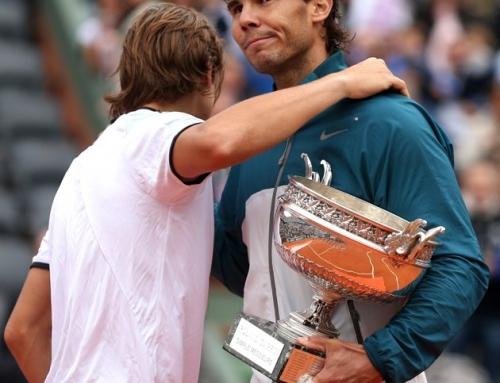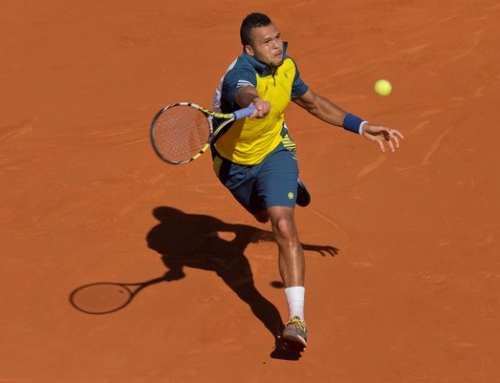 Fans have been anticipating a Federer-Nadal final ever since the French Open started. After all, Nadal had pulled off the “triple” by winning Monte Carlo, Rome, and Madrid, the first time any player had won three Masters 1000 events on clay. And Federer, who keeps reaching Slam finals. The last time Federer failed to reach a Slam final was the 2008 Australian Open. Few people had anyone else on the list of potential winners.
Fans have been anticipating a Federer-Nadal final ever since the French Open started. After all, Nadal had pulled off the “triple” by winning Monte Carlo, Rome, and Madrid, the first time any player had won three Masters 1000 events on clay. And Federer, who keeps reaching Slam finals. The last time Federer failed to reach a Slam final was the 2008 Australian Open. Few people had anyone else on the list of potential winners.
Heading into the French, the following were considered remote possibilities to win: Fernando Verdasco, who reached the finals of Monte Carlo, won Barcelona, and runner-up in Nice. Then, David Ferrer, who reached the semifinals of Monte Carlo, Barcelona, and Madrid, and reached the finals of Rome. Ernests Gulbis beat Roger Federer in the 2nd round of Rome and took a set off Nadal in the semifinals, almost pulling off the rare double: defeating both Federer and Nadal in the same tournament. The first two showed consistently good results on clay. Gulbis was beginning to show some of the talent and toughness needed to beat the game’s best.
These three were considered favorites based on their clay court performance. However, all three had suffered losses to Nadal, and two (Ferrer and Gulbis) had also lost to Federer. This gave reasons to think that despite a great clay resume, none of these three were ready to take the mantle from the top 2.
There were two other names in the play. One was last year’s surprise finalist, Robin Soderling. Soderling reached the finals of Barcelona losing to Verdasco, but had indifferent results in Rome and Madrid. To be fair, Soderling didn’t have such great results last year when he made a surprise win. One reason Soderling is a popular choice is that when he plays as well, he is among the hardest hitters in the game, comparable to Verdasco and del Potro. Soderling has already reached the quarterfinals where he’ll meet Roger Federer, though he is 0-12 against Federer.
The other name is one that people should have talked about, but has had so much drama in recent months, that he was pretty much ignored, is two-time French Open semifinalist, Novak Djokovic. Let’s examine this drama. Normally, Djokovic is as comfortable on hard courts as clay. However, he felt he needed to rework his serve, allegedly for shoulder issues. It’s hard to tinker with a world class shot, especially one as important as the serve, and not expect some issues to arise. Maria Sharapova is one of those players that has tried to rework her serve and it lead to numerous double faults.
Djokovic lost in the 4th round in Indian Wells. He then lost in his opening round in Miami to Olivier Rochus. Once action went to clay, he reached the semifinals of Monte Carlo losing to Fernando Verdasco, a respectable result, but what was worrisome was the score, a lopsided 6-2, 6-2. Then, he lost again to Verdasco in the quarterfinals of Rome, a three setter that he seemed capable of winning. Then, in his home tournament, Belgrade, he lost to Filip Krajinovic, who needed a wildcard just to play. Djokovic blamed allergies for his woes and chose to skip Madrid to recover and train.
So, by the time the French Open started, no one knew how Djokovic was doing. Had he recovered? Was he really ready to play two weeks? Two losses to Verdasco raised questions whether he could beat the second tier players, those just outside the top 5. During this whole period, Djokovic was either ranked 2 or ranked 3.
Djokovic ended up with a pretty sweet draw. The first seeded player he met was 31st seed, Victor Hanescu, in the 3rd round. He played Korolev in the opening round, then Nishikori, who had been playing challengers to get himself back after having been off the tour due to elbow injury for more than half the year last year. In the fourth round, the high seed was Juan Carlos Ferrero, seeded 16th, in other words, the lowest possible seed he could have faced. And Ferrero didn’t even make it. Instead, a plucky Robby Ginepri, who upset Sam Querrey in the first round, also upset Ferrero in five sets.
On paper, this match shouldn’t have been close. Ginepri and Djokovic had only met 4 times, but Djokovic had won all 4 times, and never dropped a set. The only time they met on clay was in 2005 in the first round, long before Djokovic had his breakthrough year (in 2007) where Ginepri only won 3 games. Ginepri has had some success on clay. In 2008, he had worked with Jose Higueras (as had Roger Federer) and reached the fourth round. Even so, his resume pales compared to Djokovic.
Ginepri kept the match close in the first set. They went to 4-all, when Djokovic played a solid game, broke, and served out the set. But then, Djokovic started to flake out. Normally, a steady player that doesn’t make too many errors, Djokovic started spraying balls, losing longer rallies to Ginepri and Ginepri looked solid, making good solid shots, moving Djokovic around. He broke Djokovic twice and took the second set, 6-2.
However, Djokovic has been having hiccups throughout his run in the French, dropping the second set to Korolev and Hanescu, but then playing solid tennis to win the last 2 sets comfortably. And so the pattern continued. The errors went away on his end and Ginepri began missing more, and Djokovic took the last two sets 6-1, 6-2.
Djokovic will again face a player that wasn’t expected to be there: Jurgen Melzer. David Ferrer was Djokovic’s expected opponent. However, Ferrer lost in straight sets to Jurgen Melzer. Melzer faced Teimuraz Gabashvili, a hard hitting player who upset (if that’s the right word) Andy Roddick. Gabashvili has already played 3 matches more than most, since he qualified to play in the main draw.
For a while, Gabashvili kept close to Melzer. He was pushing Melzer around, but Melzer has some power and speed of his own. Even so, this is Melzer’s best result in a Slam. He often loses in the first three rounds and has never reached the quarters of a Slam. Melzer took the first set in a close tiebreak. Gabashvili kept it close in the second set and took it 6-4. Melzer then used his veteran savvy and took sets 3 and 4 by the scores of 6-1 and 6-4.
Unusually, Nadal and Bellucci have had 12 breaks of serve. Nadal has been broken 4 times. Bellucci might have had a chance if he could have held his own serve. Nadal is probably going to complain how poorly he played. Bellucci has decided to play the way most play against Nadal: hit big. Even so, Nadal took the first set 6-2, struggled to take the second set, 7-5, and finally takes the third set, 6-4. When you play the “hit big” strategy, you need this to be a natural playing style. Del Potro would beat Nadal because he wasn’t playing outside his comfort zone, but Bellucci is probably playing outside his comfort zone.
And that leaves one more fourth round match to be completed. Almagro is a big hitter and took the first set, 6-1. Verdasco has come back to take the second set, 6-4, but Almagro is now up 5-0 in the third set. Verdasco played a ton of clay tournaments. In addition to playing Monte Carlo, Rome, and Madrid, he also played Barcelona and Nice and reached the finals of Nice that was played just before the French. One wonders whether Verdasco has played too much tennis and is tired.
If Almagro wins, he’ll try again to outhit Nadal as he did in Madrid where he won a set off Nadal, but was unable to beat Nadal. Almagro has the kind of game that can upset Nadal, but he has to be perfect. He can’t lapse too much. And of course, he still has to beat Verdasco.
Tomorrow, Roger Federer will play his toughest match so far against Robin Soderling. Federer has never lost to Soderling, but like del Potro who Federer had a great record against, Soderling has the kind of game that can bother Federer. In the end, he’ll be favored to win. Federer will hope to play sublime tennis and beat Soderling quickly, but that seems unlikely. In the other quarters, Tomas Berdych will play Mikhail Youzhny. The two have played 10 times, and Youzhny has a 6-4 lead, but one of Berdych’s win was a walkover. Certainly, Youzhny will feel confident playing Berdych and he is playing well. Still, either player could win.




![[French Open] The tactics of the Djokovic-Nadal semifinals](https://www.essentialtennis.com/wp-content/uploads/2013/06/20130607nole-500x383.jpg)
![[French Open, SF] David Ferrer defeats Tsonga in straight sets to reach first Slam final](https://www.essentialtennis.com/wp-content/uploads/2013/06/20130607ferrer-500x383.jpg)
![[French Open, SF] Nadal escapes epic 5-setter with win over Djokovic, to compete for 8th title](https://www.essentialtennis.com/wp-content/uploads/2013/06/20130607rafa-500x383.jpg)
